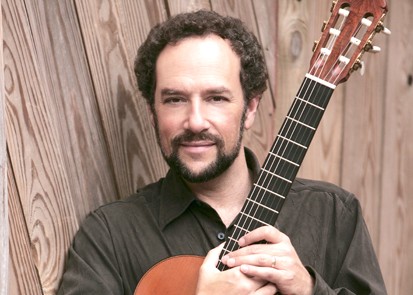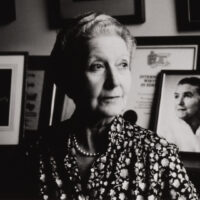
Five Questions: William Kanengiser
"Getting a broad education helps music majors become well-rounded artists and individuals."
By
The relationship between a music student and his or her professor is, quite possibly, the most important connection USC Thornton students will develop while attending the university. This semester, USC Thornton wanted to give current and prospective students a chance to get to know several members of our world-class faculty — as teachers, mentors, musicians and members of the USC Thornton community. Check back throughout the semester for more installments in the Five Questions series.
William Kanengiser
William Kanengiser is recognized as one of the finest and most creative classical guitarists performing today. His relationship with the USC Thornton School of Music goes back to 1977, when he began his studies with James Smith and Pepe Romero as an eager freshman. In his junior year, he became a founding member of the USC Guitar Quartet — which later became the GRAMMY Award-winning Los Angeles Guitar Quartet (LAGQ). He joined the faculty of the Classical Guitar Department at USC Thornton in 1983. He was given the Dean’s Award for Excellence in Teaching in 2011, and the Dean’s Award for Excellence in Professional Activities in 2013. Kanengiser is one of America’s most sought-after classical guitar soloists, and he regularly performs around the United States, Asia and Europe. He is especially in demand for his masterclasses and workshops, given in many important music conservatories from Shanghai to Weimar.
How would you describe the spirit of the USC Thornton classical guitar community?
There are many fine university and conservatory programs for the guitar — but I think one aspect that sets USC Thornton apart is the truly supportive environment. Every student is pushed to reach his or her own potential, but never with a sense of one-upmanship. It’s part of the legacy of Jim Smith, who helped to create a feeling of the department being almost a “family,” rather than a collection of students, and also by the nurturing manner of Pepe Romero. If you speak to any former or current student, I’m sure they would tell you the same. The feeling among the faculty and students reflects a caring, respectful, and positive attitude.
What special career development projects are current USC Thornton classical guitar students or recent graduates involved with?
Getting all the skills and strategies for building a professional life with the guitar is one of our primary goals for USC Thornton guitarists. Of course, technical competence and musical understanding are vital tools — but we realize that they’re only a part of starting a career. Learning to become comfortable onstage and developing a personal style that sets one apart is important. One of the requirements for all students is participation in USC Thornton Outreach concerts, where students play for appreciative audiences at the Braille Institute, the Rescue Mission and nursing homes throughout Los Angeles. The USC Guitar Orchestra, which I conduct, has performed in major venues in Los Angeles, including the Los Angeles County Museum of Art and Soka University. I also helped to organize a tour for the Helios Guitar Quartet, which is made up of recent graduates, and assisted students Andras Csaki and Mak Grgic with career development strategies. We try to act as mentors for motivated students to help start their lives as performers.
What is the importance of masterclasses at USC Thornton?
No matter how good the individual instructor, we feel that it’s vital for students to be exposed to alternative viewpoints and ideas. Masterclasses are a mainstay of our program. Not only are these classes inspirational — but they also give a chance to showcase our students to the community, and give yet another high-profile performance opportunity to the students. We are so fortunate to have Pepe Romero come twice each semester, first to give private lessons to each student, and then to give his famous public masterclasses. We also hold at least four other classes each year with respected figures in our field. Last year, we welcomed Roland Dyens, Paul O’Dette, Eden/Stell Duo and David Russell to campus. Not a bad lot!
Why is it important for music students to explore and take advantage of many opportunities available at USC outside of USC Thornton?
As a six-year Trojan student, a thirty-year Trojan professor, and a two-year Trojan father, I’ve seen USC from all perspectives. I’ve absolutely loved all of my roles and relationships with USC, and I couldn’t think of any school I’d rather be associated with. Some students want a really targeted learning environment that only focuses on music and their instrument. You can easily have that at USC Thornton if you so desire — but for the majority of students, I find that getting a broad education helps music majors become well-rounded artists and individuals. USC stands alone in what it can offer as a world-class conservatory surrounded by a world-class academic and research institution. With access to leaders in almost every discipline imaginable, USC Thornton guitarists have studied subjects ranging from astronomy to zoology — with plenty of jazz, flamenco, neuroscience and semiotics in between.
What’s your favorite recipe?
Oh, so many! But how about this one I just made for an al fresco picnic at the Hollywood Bowl:
Panini caprese con pollo
Cooking time: 20 minutes Prep time: 40 minutes Makes four paninis
Ingredients
1 lb. boneless, skinless chicken breasts ½ cup extra-virgin olive oil 2 tbsps. balsamic vinegar ½ tsp. dried oregano 1 ½ cups fresh basil leaves 1 clove fresh garlic ¼ cup raw pine nuts ¼ cup of grated parmesan or pecorino cheese four ripe tomatoes two balls of good-quality, fresh mozzarella cheese (buffalo is best) four fresh rustic Italian-style rolls balsamic glaze (optional)
Marinate chicken breasts in ¼ cup of olive oil, vinegar, oregano, salt and pepper to taste (marinate for 60 minutes or longer)
To make the pesto: Wash and dry 1 cup fresh basil. Crush one garlic clove, place in food processor or blender and puree. Add basil until leaves are finely crushed. Sprinkle in salt and freshly ground pepper to taste, add pine nuts and blend. With processor running, drizzle in about ¼ cup of high-quality olive oil, until just emulsified. Stir in grated parmesan or pecorino cheese.
Preheat grill, set marinated chicken breasts out to come to room temp. Grill on medium to high until cooked through. Set aside to cool.
Slice ripe tomatoes into ¼ inch slices and mozzarella into ¼ inch slices. Gently pat the tomato and cheese slices dry with paper towels to remove extra moisture. Slice fresh rolls in half. Once the grilled chicken has cooled a bit, slice into ¼ inch slice on the diagonal.
Assemble the sandwiches: Liberally brush the bottom slice of the roll with pesto, place a layer of sliced chicken, then a layer of sliced mozzarella, then a basil leaf, then a slice of tomato. If desired, drizzle some balsamic glaze and put the top of the roll on the whole assembly. If desired, grill in a Panini press, or simply cut in half and enjoy. Mangia!

